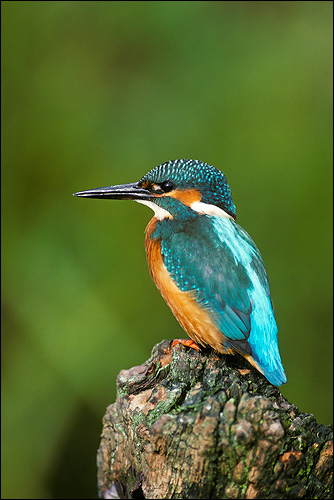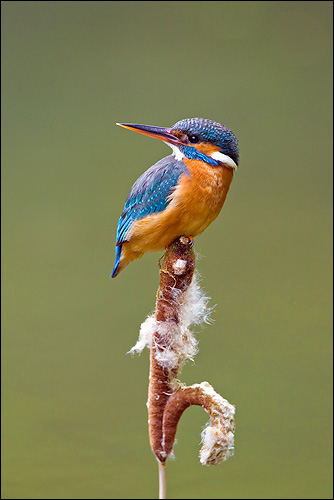Alpine Chough (Pyrrhocorax graculus)
Catching fish is no easy matter if you start from a perch. For one thing you have to spot the shy creatures in the first place, which may not be easy, especially if light is glinting off the water surface or the water is stirred up by wind. Then, before you strike, you must estimate how far down the target is, a process rendered tricky by refraction which makes underwater objects look closer than they are. And then, of course, you must plunge in and get them, a process which requires considerable skill.
Somehow, though, the Kingfisher makes a living in this way, and its prime weapon is its remarkable eyesight. It has exceptional colour vision produced by oil-droplets in the retina, and that helps to detect the fish amidst the subtle and shifting colours of a river. It also has an unusual arrangement of the eye that gives it highly sensitive all round vision with one position of the head and equally sensitive overlapping or “binocular” vision, to help judge distance, with another. When a Kingfisher is watching below it, with its head angled down at 60°, it can shift between the two types of vision with a small turn of the head, thereby first spotting a fish and then measuring how far away it is. The rest – allowing for refraction, and adjusting its dive accordingly – is probably mostly down to practice. It certainly works, because one study found that 50% of all dives are successful.
Although the Kingfisher primarily feeds on small fish, it does eat some other food items as well. In Britain, for example, the diet in one survey was found to constitute 60% fish and 20% insects, whereas in Spain a survey came up with 78% fish and 10% crustaceans. Frogs sometimes hop on to the menu, as do molluscs and butterflies, and the latter may actually be caught in flight, without recourse to a plunge-dive. Although Kingfishers usually obtain their food from a perch, they are perfectly capable of hovering above the water instead.
Kingfishers breed beside still or slow-flowing water with an abundant supply of small fish, together with plenty of waterside vegetation to provide look-out perches over the water. Another necessity, of course, is a suitable earthen bank in which to excavate the nest. For this, both birds dig on and off for between 4 and 7 days before they finally complete a tunnel with a slightly raised chamber at the end that is 12-15 cm across, on to which the eggs are laid directly. Just before it is complete the male begins a rigorous regime of plying the female with food, ritually presenting a fish to her while they are sitting side by side on a perch.
The young are fed in a remarkable way. Instead of the usual unseemly free-for-all seen in most nests of young birds, the nestlings are fed in strict rotation, literally. Sitting in a circle back to back, only one chick faces the light coming from the tunnel entrance each time; when a parent comes in with a fish, it is fed and then, democratically enough, it stands aside for the next chick to be fed, and everyone moves round, like slides in a carousel.
Habitat For breeding, fresh still or slow-flowing water – especially rivers. In winter may be found on the coast and by large lakes.
Food Fish are mainstay, plus some crustaceans, insects, amphibians and molluscs. Caught by plunge-diving. Fish are beaten on perch to stun them and are invariably swallowed head first.
Movements Migratory in Central, East and North Europe, but resident in the west and south-west.
Voice High pitched whistle, of same pitch as squeaking car brakes.
Pairing style Monogamous, but regularly change partners, both year by year and between broods
Nesting Solitary and territorial.
Nest Chamber at the end of a burrow dug by the birds themselves, 50-90 cm long.
Productivity 1-2 broods a year, exceptionally 3.
Eggs 6-7
Incubation 19-21 days, by both sexes (mainly female at night).
Parenting style Young are fed by both parents, at first using the “carousel” system (see text).
Young Altricial; naked at first.
Food to young Fish, regurgitated at first, but soon whole.
Leaving nest Young fledge at 23-27 days, then are fed by the parents for about 4 days before becoming independent.


